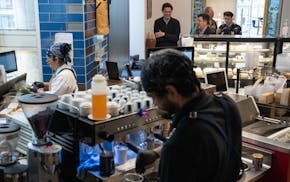At a CVS store in a racially diverse neighborhood in Brooklyn Center, the only devices available to shoppers to measure their blood-oxygen levels are virtually unregulated fingertip oximeters that may be less accurate in people with darker skin.
So-called "health and wellness" pulse oximeters available online and at pharmacies — like the $50.99 CVS Health Pulse Oximeter, made by a subsidiary of Tianjin Chase Sun Pharmaceutical ― do not require extensive testing, despite criticism that inaccurate readings from such devices lead to health disparities for people of color.
New, long-awaited government guidelines likely won't change this.
Draft guidance released Monday by the Food and Drug Administration strengthens pulse oximeter accuracy and testing recommendations for some devices, but stops short of outlining new rules regulating the most easily accessible and affordable devices for consumers.
The guidance follows public uproar over how inaccurate readings led to different medical care for patients of color during the pandemic. During the pandemic, Black patients died from COVID at twice the rate as white patients who got the virus.
"Pulse oximetry was often used as a single technology that drove clinical decision making," said Frank Chan, president of the acute care and monitoring division at Medtronic, which is run from offices in Fridley.
CEO John Hastings of Plymouth's Nonin Medical, which launched the fingertip pulse oximeter in 1995, says unregulated health-and-wellness devices' performance in general has been "just flat-out atrocious in many cases, in particular for dark-skin patients." Nonin recently received FDA clearance for a clinical-grade product intended to be used by patients at home called the TruO2 OTC, available to consumers on Amazon for $299.
Nonin and Medtronic were working on boosting clinical trial diversity and the accuracy of their medical-grade oximeters before the long-awaited release of the FDA's draft document. Once finalized, the guidelines will increase the minimum size of the pool of participants for oximeter-accuracy testing from 10 to 150, and require at least 25% of trial participants to have dark skin tone, instead of just 15%.
But that's for devices that hit the market with FDA clearance, which are mainly used in medical settings. Some observers have concerns that the new recommendations don't regulate the health and wellness devices most accessible to consumers, and that requiring such testing would be too demanding for manufacturers.
Dr. Michael Lipnick, a professor at the University of California San Francisco and an investigator at the UCSF Hypoxia Lab — an independently funded nonprofit that conducts research on pulse oximeters — said it's good that the FDA increased the size of the testing pool, but called the jump to 150 participants "potentially very problematic."
" This could have major implications," Lipnick said in an email. "Very few companies in the world can do such large studies."
A spokesperson for CVS said that most of its stores carry at least one pulse oximeter model, and some carry two.
"We're committed to ensuring the products we offer work as intended, satisfy customers, and comply with all applicable laws, regulations and FDA guidance," the statement said.
How does it work?
Pulse oximeters reveal oxygen saturation levels by shining bright light through tissue, measuring how the blood absorbs light while subtracting signals not involving the pulse, Lipnick said in an interview.
"The problem is, anything that interferes with any of that process can screw things up," said Lipnick, who's also the associate director for UCSF's Center for Health Equity in Surgery and Anesthesia.
For example, tattoos and ambient light can reduce the accuracy of pulse oximeters that clip to the fingertip. And researchers have long known of data showing the devices don't work as well in people with darker skin.
(Note: A previous version of this story contained a chart showing purchase prices and lifetime costs of pulse oximeters as of Jan. 8 from openoximetry.org. The chart has since been removed because of questions about how the data displayed and amended online after the story's initial publication.)
Scientists theorize that higher levels of melanin in the skin can change oximeters' perception of blood color, and not all devices are accurately calibrated to account for this, Lipnick said, adding that a lot is still unknown about this interaction. Studies have found that pulse oximeters miss three times as many cases of low-oxygen levels in Black patients as in white patients.
That disparity caused an outcry during the early days of the COVID pandemic.
A 2023 study in the American Journal of Epidemiology found pulse oximetry systemically overestimated oxygen levels in Black individuals compared with white individuals. That meant Black patients had a lower chance of getting dexamethasone, supplemental oxygen or a hospital admission.
"Oximeters are absolutely essential tools, and anything that is done to lose faith in the devices is a real setback," Lipnick said.
A group of state attorneys general including Minnesota Attorney General Keith Ellison signed a November 2023 letter urging the FDA to prioritize the development of better research and regulatory guidance to eliminate disparities.
At an FDA advisory committee meeting last February, officials outlined proposed guidance that would increase clinical study sizes from 10 to 24 participants. The guidance released Monday goes further, increasing the study size 15-fold.
The new guidance recommends companies test the devices in patients with wider ranges of skin tones, including from three subgroups of the 10 levels in the subjective Monk Skin Tone scale. The FDA also recommended companies assess participants using an objective, math-based process called colorimetry to find a second metric of skin color.
The FDA also tightened the accuracy recommendations of pulse oximeters.
Rachel Brummert, the consumer representative at the FDA the meeting in February, said last week that the previously proposed increased trial number of 24 seemed too low. The recommendation of 150 participants is surprising and relieving, Brummert said.
"It is a drastic difference from what we were expecting," Brummert said in an email.
Lipnick, though, said some companies with large, diverse study cohorts claim their devices have no bias with skin pigment, despite independent research suggesting otherwise.
The "net effect" of the new recommendation, Lipnick said, "may be some of the same devices with bias make it to the market and there is less competition."
The guidance is not final and is open to comments and suggestions for 60 days. In a statement, the FDA said it will review and consider comments before finalizing the recommendations.
Taking on unregulated devices
On a recent weekday, four workers sat a few feet apart in Nonin's tidy manufacturing space, assembling the company's flagship 9590 pulse oximeters, which are intended to be used by medical professionals in settings like hospitals, nursing homes and home health care services.
One employee soldered, others assembled, and a final one tested a device that generally ranks as more accurate than competitors', according to data from independent testing that is searchable on the Hypoxia Lab's Open Oximetry website.
The TruO2 device, which advertises accurate readings "across all skin tones," uses the same hardware and algorithm as the device in the study, Hastings said. Nonin will sell it on Amazon for $299 and will break down accuracy by skin type in the owner's manual, which is not a requirement, he said.
Patients with long-lasting conditions such as chronic obstructive pulmonary disease (COPD) are often required to monitor their blood oxygen levels, but they may end up relying on non-FDA-cleared health and wellness devices if Medicare or private insurance won't cover an oximeter, Hastings said.
The FDA said a large number of devices available over the counter "have not been evaluated by the FDA for use in clinical decision-making or for determining whether to seek medical intervention." The TruO2 device is one of a few pulse oximeters intended for medical purposes currently available over-the-counter following clearance by the FDA.
Hastings said lower-quality devices often don't include an expensive component that filters and cleans the signal coming into the device. Manufacturers may also fail to include data from individuals with darker-colored skin in their algorithms.
Hastings said Nonin has gone beyond the FDA requirement for the inclusion of dark-skinned patients in its studies for more than a decade.
Boosting trial diversity
Yahya Hamu, a Black 21-year-old University of Colorado Denver student eyeing a Medtronic internship, let the company deplete the oxygen from his body. And it wasn't just to land a prestigious early-career role.
Hamu's oxygen-depletion data was included in the medtech giant's pulse oximeter testing pool, leaving him feeling proud for contributing to an important project.
Before his arrival at the company's new clinic in Denver's historically Black Five Points neighborhood, Hamu was "feeling a little anxious, a little nervous." Staff took him to a room with tubes and monitors and a big metal tank of oxygen, placing a mask over his mouth and face. They decreased oxygen levels every 5 minutes.
"It gets harder and harder to breathe," Hamu said. He has climbed a few mountains, though, so the thin air wasn't too discombobulating. At the end, Hamu was breathing hard and sweating. His fingers felt cold.
"You kind of have to tell yourself and motivate yourself that you are doing something for research, and that this will lead to the betterment of the medical world," Hamu said.
Medtronic's Chan said more than 25% of its clinical trial participants have dark skin pigment. The company's Nellcor pulse oximeter also tends to perform well compared with other oximeters, according to Open Oximetry data.
Previously, the company hired third-party firms to carry out testing, Chan said. Now, some participants walk the company's new lab in Five Points.
Hamu said the historically inaccurate results from pulse oximeters feel unfair. He's willing sacrifice his time to buck the trend, he said.
"I just hope one day I can see an actual accurate machine, regardless of skin pigmentation," Hamu said.

Why now might be the best time to make a deal on boats, ATVs and other powersports

To reset downtown Minneapolis skyway life, building owners cut deals with retailers

Ramstad: AI is English-centric, but it's picking up Hmong quickly
Don't throw away perks that come with insurance and memberships

